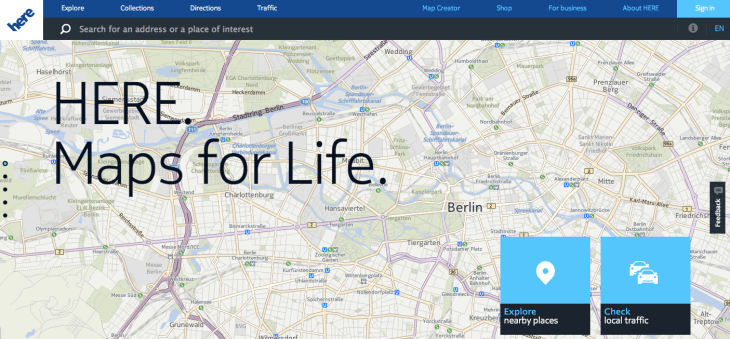In most people’s minds, Nokia is still a mobile phones company. But if the Nokia board approves the sale of “substantially all” of the company’s devices & sales division to Microsoft – announced back in September and due to close early next year (if it gets the nod) – then 2014’s Nokia will be a very different beast.
Leaner, as it passes some 32,000 employees to Microsoft and focuses on three business units: the NSN networking business; its HERE location services unit; and a new division called Advanced Technologies which incorporates its patent portfolio, plus R&D work in areas including connectivity, sensing, materials, and web and cloud technologies.
And meaner – in terms of how it competes. Expect Nokia’s positioning of its HERE digital maps business to focus on attacking Google’s ad-focused business model for digital mapping and location services.
“Compared to Google’s less flexible, and advertising driven approach, we believe HERE’s strategy is far better aligned with the needs of a broad range of existing and future customers,” said Nokia CFO Timo Ihamuotila, during a conference call today, following Nokia’s Q3 earnings.
Ihamuotila said “flexibility” will be a key differentiator for HERE vs the competition, as it focuses on tailoring location services to the needs of HERE customers. He made a point of emphasising that Nokia’s location services unit would be an “independent” player in the space — doubtless thanks in part to Nokia dropping out of the mobile game itself, allowing it to focus fully on serving the location needs of its customers.
But also another side-swipe aimed at Google — with HERE being positioned as an alternative for “companies who care a lot about their core brand and customer relationships”, as Ihamuotila put it.
“Google’s all or nothing approach towards licensing its suite of services can also cause conflicts,” he said. “We believe HERE’s positioning and flexible offering is a key differentiator.”
While to-date HERE has been “most visible” in the automotive sector, Ihamuotila said Nokia would be ramping up to attack other industries to drive future growth. “HERE is well positioned as a neutral entity that can serve multiple players in multiple industries,” he added. “Becoming a strategic partner that delivers cloud-based content and platform solutions to multiple industries in the future.”
Patent power
Another area where Nokia appears to be sharpening its claws to compete more aggressively in a post phone-making future is patents.
Nokia’s IP portfolio falls under the Advanced Technologies business unit which also includes its main R&D division. That portion of Nokia’s business has of course been heavily involved in IP creation to date. And Nokia is hoping it can continue to be a pipeline for new, licensable ideas in future.
“The team is responsible for more than half of our new patent filings, excluding NSN,” noted Ihamuotila during the call. “We are confident that we will see the organisation continue to deliver innovations to support future growth, as well as the renewal of our patent portfolio.”
Discussing Nokia’s existing patent pile, built up over the past 25 years, Ihamuotila said the company sees “strong opportunities” to expand its licensing “coverage” (and therefore IP-related earnings) by going after “presently unlicensed vendors” — a comment that may send a few chills down the spines of Android OEMs and other phone makers (excluding future phone-maker Microsoft, of course). Nokia filed another patent claim against HTC back in May, for instance. It’s presumably gearing up for more such actions next year.
Nokia stepping out of the phone-making game itself, assuming the Microsoft transaction goes through, will also free it up to be more liberal about licensing its portfolio of non-standards essential patents — giving it another front to ramp up its IP licensing revenues. Since it won’t be making phones itself, it can afford to license some of the patent-protected differentiating features it had developed for its own devices to other mobile makers.
“Since Nokia started its licensing program several years ago, we have primarily licensed our standards essential patents — retaining the patents protecting the proprietary features of our products for our own exclusive use,” said Ihamuotila.
“Subject to the closing of the transaction with Microsoft we will have further flexibility in making many of these technologies available to the broader market, which will provide us with new technology creation and licensing opportunities.”
